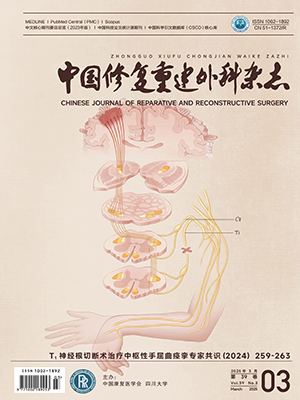Objective To investigate the cl inical characteristics and methods of diagnosis and treatment of multiple level thoracolumbar spinal fractures. Methods From March 2002 to March 2006, 17 patients with 35 thoracolumbar spinal fractures were treated, 13 males and 4 females, aged 21-52 years old (36.4 on average), among whom there were 10 cases of traffic accident injury and 7 of high fall ing injury. One fracture was located at T2, 1 at T3, 1 at T10, 4 at T11, 6 at T12, 5 at L1, 3 at L2, 7 at L3, 5 at L4, and 2 at L15, with a total of 35 segments including 26 segments with unstable fractures and 9 segments with stable compression fractures. According to the Frankel grade, there was 1 case of grade A, 1 of grade B, 2 of grade C, 5 of grade D and 8 of grade E. The preoperative height of the anterior border of the vertebral body was (20.8 ± 3.8) mm and the preoperative kyphosis angle was (16.2 ± 3.4)°. All the unstable fractures were performed operation. Sixteen injured vertebras were treated with long-segment pedicle screw internal fixation; 8 were treated with short-segment pedicle screw internal fixation, and 2 were treated with anterior fusion and fixation. Five injured vertebras with stable compression fractures were not treated and 4 were treated with pedicle screw implantation. Results The operation time was 1.8-4.2 hours and the amount of blood loss was 300-900 mL. The incisions obtained heal ing by first intention after the operation. All 17 patients were followed up for 13-41 months (18 months on average), and radiological evaluation showed no failure of the internal fixation. After the operation, the Frankel scale assessment showed that 1 patient of grade A improved to grade B, 1 of grade B improved to grade C, 1 of grade C improved to grade D, 1 of grade C improved to grade E, 5 of grade D improved to grade E, and 8 of grade E had no improvement. At the final postoperative follow-up, the height of the anterior border of the vertebral body was (31.9 ± 3.2) mm and the kyphosis angle was (6.8 ± 3.7)°, which were significantly different from those of preoperation (P lt; 0.01). Conclusion The treatment of multiple level thoracolumbar spinal fractures should be individual ized according to the patients’ actual conditions in order to obtain decompression and stabil ity of spines.
Citation: DANG Hongsheng,ZHAO Meng,YAN Yongxiang,LIU Jiaguo,ZHANG Jinsong,XU Shengkang,LUO Bin.. CLINICAL DIAGNOSIS AND TREATMENT OF MULTIPLE LEVEL THORACOLUMBAR SPINAL FRACTURES. Chinese Journal of Reparative and Reconstructive Surgery, 2008, 22(12): 1441-1444. doi: Copy
Copyright © the editorial department of Chinese Journal of Reparative and Reconstructive Surgery of West China Medical Publisher. All rights reserved




